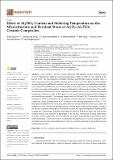Por favor, use este identificador para citar o enlazar a este item:
http://hdl.handle.net/10261/257351COMPARTIR / EXPORTAR:
 SHARE SHARE
 CORE
BASE CORE
BASE
|
|
| Visualizar otros formatos: MARC | Dublin Core | RDF | ORE | MODS | METS | DIDL | DATACITE | |

| Título: | Effect of Al2TiO5 Content and Sintering Temperature on the Microstructure and Residual Stress of Al2O3-Al2TiO5 Ceramic Composites |
Autor: | Fan, Kunyang; Jiang, Wenhuang; Ruiz Hervias, Jesús; Baudín de la Lastra, Carmen CSIC ORCID; Feng, Wei; Zhou, Haibin; Bueno, Salvador CSIC ORCID CVN; Yao, Pingping | Palabras clave: | Al2TiO5 Ceramics Crystal structure Residual stresses Neutron diffraction |
Fecha de publicación: | 11-dic-2021 | Editor: | Multidisciplinary Digital Publishing Institute | Citación: | Materials 14(24): 7624 (2021) | Resumen: | A series of Al2O3–Al2TiO5 ceramic composites with different Al2TiO5 contents (10 and 40 vol.%) fabricated at different sintering temperatures (1450 and 1550 °C) was studied in the present work. The microstructure, crystallite structure, and through-thickness residual stress of these composites were investigated by scanning electron microscopy, X-ray diffraction, time-of-flight neutron diffraction, and Rietveld analysis. Lattice parameter variations and individual peak shifts were analyzed to calculate the mean phase stresses in the Al2O3 matrix and Al2TiO5 particulates as well as the peak-specific residual stresses for different hkl reflections of each phase. The results showed that the microstructure of the composites was affected by the Al2TiO5 content and sintering temperature. Moreover, as the Al2TiO5 grain size increased, microcracking occurred, resulting in decreased flexure strength. The sintering temperatures at 1450 and 1550 °C ensured the complete formation of Al2TiO5 during the reaction sintering and the subsequent cooling of Al2O3–Al2TiO5 composites. Some decomposition of AT occurred at the sintering temperature of 1550 °C. The mean phase residual stresses in Al2TiO5 particulates are tensile, and those in the Al2O3 matrix are compressive, with virtually flat through-thickness residual stress profiles in bulk samples. Owing to the thermal expansion anisotropy in the individual phase, the sign and magnitude of peak-specific residual stress values highly depend on individual hkl reflection. Both mean phase and peak-specific residual stresses were found to be dependent on the Al2TiO5 content and sintering temperature of Al2O3–Al2TiO5 composites, since the different developed microstructures can produce stress-relief microcracks. The present work is beneficial for developing Al2O3–Al2TiO5 composites with controlled microstructure and residual stress, which are crucial for achieving the desired thermal and mechanical properties. | Versión del editor: | https://doi.org/10.3390/ma14247624 | URI: | http://hdl.handle.net/10261/257351 | DOI: | 10.3390/ma14247624 | ISSN: | 1996-1944 |
| Aparece en las colecciones: | (ICV) Artículos |
Ficheros en este ítem:
| Fichero | Descripción | Tamaño | Formato | |
|---|---|---|---|---|
| materials-14-07624-v3.pdf | 4,74 MB | Adobe PDF |  Visualizar/Abrir |
CORE Recommender
SCOPUSTM
Citations
8
checked on 21-abr-2024
WEB OF SCIENCETM
Citations
8
checked on 27-feb-2024
Page view(s)
33
checked on 24-abr-2024
Download(s)
143
checked on 24-abr-2024
Google ScholarTM
Check
Altmetric
Altmetric
Este item está licenciado bajo una Licencia Creative Commons

